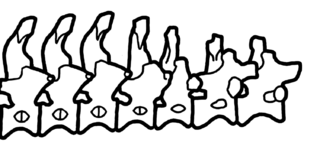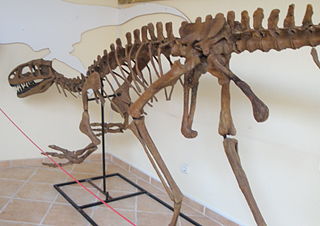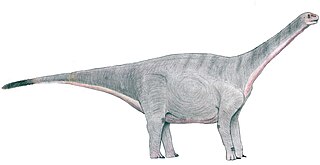
Torvosaurus is a genus of carnivorous megalosaurid theropod dinosaur that lived approximately 165 to 148 million years ago during the late Middle and Late Jurassic period in what is now Colorado, Portugal, Germany, and possibly England, Tanzania, and Uruguay. It contains two currently recognized species, Torvosaurus tanneri and Torvosaurus gurneyi, plus a third species from Germany that is currently unnamed.

Giraffatitan is a genus of sauropod dinosaur that lived during the late Jurassic Period in what is now Tanzania. It was originally named as an African species of Brachiosaurus (B. brancai), but this has since been moved to its own genus. Giraffatitan was for many decades known as the largest dinosaur but recent discoveries of several larger dinosaurs prove otherwise; giant titanosaurians appear to have surpassed Giraffatitan in terms of sheer mass. Also, the sauropod dinosaur Sauroposeidon is estimated to be taller and possibly heavier than Giraffatitan.

Janenschia is a large herbivorous sauropod dinosaur from the Late Jurassic Tendaguru Formation of Tanzania, Africa, 155 million years ago.

Draconyx is a genus of dinosaur from the Late Jurassic. It was an ornithopod which lived in what is now Portugal and was a herbivore. It was found in the Lourinhã Formation in 1991, and described by Octávio Mateus and Miguel Telles Antunes in 2001.

Dinheirosaurus is a genus of diplodocid sauropod dinosaur that is known from fossils uncovered in modern-day Portugal. It may represent a species of Supersaurus. The only species is Dinheirosaurus lourinhanensis, first described by José Bonaparte and Octávio Mateus in 1999 for vertebrae and some other material from the Lourinhã Formation. Although the precise age of the formation is not known, it can be dated around the early Tithonian of the Late Jurassic.
Lourinhasaurus was an herbivorous sauropod dinosaur genus dating from Late Jurassic strata of Estremadura, Portugal.

Lourinhanosaurus was a genus of carnivorous theropod dinosaur that lived during the Late Jurassic Period (Kimmeridgian/Tithonian) in Portugal. It is one of many large predators discovered at the Lourinhã Formation and probably competed with coeval Torvosaurus gurneyi, Allosaurus europaeus, and Ceratosaurus.
Jiutaisaurus is a genus of sauropod dinosaur from the Quantou Formation of Xidi, China. Jiutaisaurus was a sauropod which lived during the Cretaceous. The type species, Jiutaisaurus xidiensis, was described by Wu et al. in 2006, and is based on eighteen vertebrae. It probably lived alongside Changchunsaurus and Helioceratops.
Octávio Mateus is a Portuguese dinosaur paleontologist and biologist Professor of Paleontology at the Faculdade de Ciências e Tecnologia da Universidade Nova de Lisboa. He graduated in Universidade de Évora and received his PhD at Universidade Nova de Lisboa in 2005. He collaborates with Museu da Lourinhã, known for their dinosaur collection.

The Tendaguru Formation, or Tendaguru Beds are a highly fossiliferous formation and Lagerstätte in southeastern Tanzania. The formation represents the oldest sedimentary unit of the Mandawa Basin, overlying Neoproterozoic basement, separating by a long hiatus and unconformity. The formation reaches a total sedimentary thickness of more than 110 metres (360 ft). The formation ranges in age from the late Middle Jurassic to the Early Cretaceous, Oxfordian to Hauterivian stages, with the base of the formation possibly extending into the Callovian.
Amargatitanis is a genus of dicraeosaurid sauropod dinosaur from the Barremian-age La Amarga Formation of Neuquén, Argentina.

The Lourinhã Formation is a fossil rich geological formation in western Portugal, named for the municipality of Lourinhã. The formation is Late Jurassic in age (Kimmeridgian/Tithonian) and is notable for containing a fauna especially similar to that of the Morrison Formation in the United States and a lesser extent to the Tendaguru Formation in Tanzania. There are also similarities to the nearby Villar del Arzobispo Formation. The stratigraphy of the formation and the basin in general is complex and controversial, with the constituent member beds belonging to the formation varying between different authors

Dongyangosaurus is a genus of saltasaurid sauropod dinosaur from the early Late Cretaceous. The only species is Dongyangosaurus sinensis, from which only a single fragmentary skeleton is known, coming from the Zhejiang province of eastern China. It was described and named by Lü Junchang and colleagues. Like other sauropods, Dongyangosaurus would have been a large quadrupedal herbivore.

Brachiosaurus is a genus of sauropod dinosaur that lived in North America during the Late Jurassic, about 154–150 million years ago. It was first described by American paleontologist Elmer S. Riggs in 1903 from fossils found in the Colorado River valley in western Colorado, United States. Riggs named the dinosaur Brachiosaurus altithorax; the generic name is Greek for "arm lizard", in reference to its proportionately long arms, and the specific name means "deep chest". Brachiosaurus is estimated to have been between 18 and 21 meters long; weight estimates range from 28.3 to 58 metric tons. It had a disproportionately long neck, small skull, and large overall size, all of which are typical for sauropods. Atypically, Brachiosaurus had longer forelimbs than hindlimbs, which resulted in a steeply inclined trunk, and a proportionally shorter tail.

Miragaia is a long-necked stegosaurid dinosaur. Its fossils have been found in Upper Jurassic rocks in Portugal and possibly also Wyoming, United States. Miragaia has the longest neck known for any stegosaurian, which included at least seventeen vertebrae.

Baotianmansaurus is a genus of titanosaur sauropod dinosaur. Its fossils have been found in Upper Cretaceous rocks in Henan, China, within the Gaogou Formation. The type species is B. henanensis, described in 2009. The holotype is 41H III-0200. Remains of the fossils were vertebrae, ribs and scapula fragments. It was probably a close relative of Opisthocoelicaudia and Dongyangosaurus in Saltasauridae.
Liubangosaurus is a genus of sauropod dinosaur that lived during the Early Cretaceous in what is now China. The type and only species is Liubangosaurus hei, first described by Mo Jinyou, Xu Xing and Eric Buffetaut in 2010. Liubangosaurus is known from the holotype NHMG8152, five nearly complete and articulated middle-caudal dorsal vertebrae that were collected from the Xinlong Formation in Fusui County, Guangxi Province. Jinyou et al. (2010) found that Liubangosaurus belonged to the clade Eusauropoda.

Zby is an extinct genus of turiasaurian sauropod dinosaur known from the Late Jurassic of the Lourinhã Formation, central west Portugal. It contains a single species, Zby atlanticus. It is named after Georges Zbyszewski, who studied the geology and paleontology of Portugal.

Suchoolithus is an oogenus of crocodylomorph eggs from the late Jurassic of Portugal. They are notable for their small size, and for being among the oldest known crocodylomorph eggs.
Wamweracaudia is a large herbivorous sauropod dinosaur from the Late Jurassic Tendaguru Formation of Tanzania, Africa, 155-145 million years ago.





























